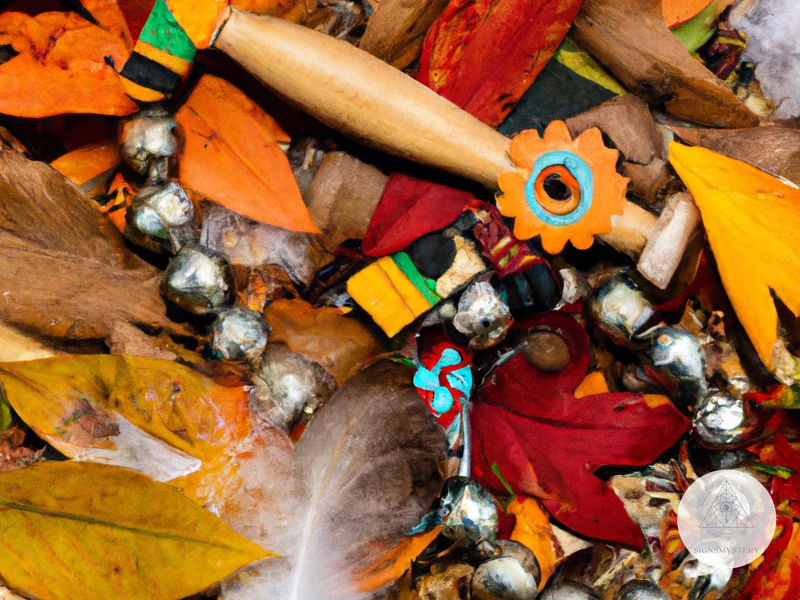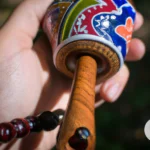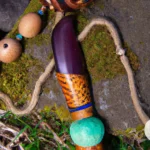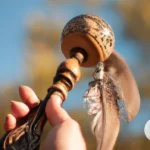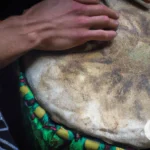The mystical practice of Shamanism has been around for thousands of years and continues to be a significant part of many cultures today. One of the essential tools used in shamanic rituals is the shamanic rattle. This instrument has been used to facilitate healing, connect with ancestors and spirits, and aid in shamanic journeys. In this article, we delve into the history and origins of shamanic rattles, explore the different types of rattles, their significance, and how to use them. We also take a look at contemporary adaptations and their role in modern Shamanism. Join us on this journey of discovery and gain a deeper understanding of the shamanic rattle.
The Origins of Shamanism
Shamanism is an ancient spiritual practice with roots in various cultures around the world. It is believed that the practice originated over 10,000 years ago, during the Paleolithic era. The word “shaman” comes from the Tungus tribe in Siberia, where the practice first received its name. Shamans were the spiritual leaders of their communities, holding immense power and knowledge of the natural world. They acted as intermediary between the physical and spiritual worlds, using various tools such as shamanic rattles to connect with spirits and perform healing rituals. Today, shamanism still plays an important role in many cultures and societies, with shamanic practices and tools like rattles being increasingly recognized for their healing and spiritual significance.
The Role of Rattles in Shamanism
In shamanism, rattles have been used as an essential tool for centuries. They serve a crucial role in connecting the shaman or practitioner with spirits from the spiritual world. The primary purpose of rattles in shamanism is to create a powerful and steady beat that helps the shaman enter a trance state, which is necessary for the shamanic journey. In this state, the shaman is believed to connect with spirits and communicate with them.
Rattles have also been used to ward off negative energies and entities by creating a protective circle with the sound. This circle can be created around the shaman or the person receiving the shamanic healing. The sound of rattles creates a frequency that clears the energy field around the practitioner, allowing them to focus on their work.
The sound of rattles in shamanism has been used for divination purposes. During the ritual, the shaman may throw the rattle and interpret the patterns it creates to receive guidance from the spirits. This method of divination is common in shamanic cultures worldwide and is still in practice today.
In shamanic cultures, rattles have also been used as a musical instrument for ceremonies and celebrations. The sound of the rattle is believed to bring joy, upliftment, and a strong sense of community. It is a way to connect with the ancestors and honor their traditions.
The use of rattles in shamanic practices is deeply ingrained in various cultures worldwide. It is a testament to the significance of the power of sound in spiritual practices. To learn more about the importance of shamanic rattles, please visit shamanic-rattles-importance.
The History of Shamanic Rattles
Shamanic rattles have been used for thousands of years in various cultures around the world. The history of shamanic rattles can be traced back to prehistoric times. The oldest known shamanic rattles were found in the Altai Mountains of Central Asia and are estimated to be over 5,000 years old. These rattles were made from bronze and had carvings of animals and mystical creatures.
In the Americas, shamanic rattles were used by indigenous peoples such as the Inca, Cherokee, and Navajo tribes. These rattles were made from various materials such as gourds, animal hides, and turtle shells. The designs on these rattles were often symbolic of the tribes’ beliefs and traditions.
During the Middle Ages in Europe, shamanic rattles were used by mystics and healers. These rattles were made from metal and were used in exorcisms.
In modern times, the use of shamanic rattles has become more widespread. They are used in various spiritual practices such as meditation and sound healing. Many people create their own shamanic rattles using materials such as seeds, beads, and crystals.
Shamanic rattles have a rich history and have been used by different cultures for various purposes. They continue to be an important tool in spiritual practices around the world today. If you’re interested in learning more about shamanic rattles and their place in shamanic practices, visit /rattles-shamanic-practices/. If you’re considering getting a rattle for your own shamanic work, /rattle-for-shamanic-work/ may be a helpful resource. And if you’re looking for tips on creating your own shamanic rattle, check out /create-shamanic-rattle-tips-and-techniques/.
Types of Shamanic Rattles

Shamanic rattles come in many different forms and designs, each with their own unique characteristics and purposes. The materials used to make the rattles can vary greatly, from animal skins and bones to wood and gourds. Some traditional designs include the Ayahuasca vine rattles from South America and the buffalo hide rattles of the Plains Indians, while contemporary rattles often feature intricate beadwork and unique shapes. The type of sound produced by the rattle is also an important factor, as some prefer a soft and subtle rattle while others prefer a louder, more forceful sound. No matter the type of rattle, they all serve the important role of aiding in shamanic journeys and connecting with spirits.
Materials Used in Rattles
Rattles have been used in shamanic practices for centuries, and the materials used to create them vary depending on the location and culture. One of the most traditional materials used for shamanic rattles is gourds. Gourds are believed to contain powerful protective qualities and are often decorated with intricate carvings or symbols to enhance their potency.
Another commonly used material is animal hide. Shamanic rattles made from animal hide can be traced back to ancient times and are still used today. The hide can come from a variety of animals, including deer, elk, and buffalo. The rawhide is typically stretched over a frame and treated with various materials to give it a unique sound.
Wood is also a popular material for shamanic rattles. Birch, cedar, and willow are all commonly used because of their natural acoustic properties.
Some shamanic practitioners also use stones and crystals in their rattles. These materials are believed to hold powerful energetic properties and are often hand-selected for their unique qualities. The stones and crystals can be used alone or combined with other materials to create a unique sound.
More contemporary materials that have been used for rattles include plastic, metal, and glass. These materials may not have the same historical significance as traditional materials, but they can still be effective in producing a clear sound and energy.
The materials used in shamanic rattles are diverse, and each material has its unique symbolic and energetic properties. The choice of material can vary depending on the shamanic practitioner’s personal preference, cultural background, and intention for the rattle. Ultimately, the chosen materials are believed to contribute to the effectiveness of the rattle in shamanic practice.
Traditional Rattle Designs
Traditional shamanic rattles come in a variety of designs, shapes, and sizes. They are often made from organic materials such as gourds, animal hides, or shells. Some of the most common traditional designs include the handle rattle and the ball rattle.
The handle rattle consists of a handle made of wood, bone, or antler, with a bulbous rattle head at the end. This type of rattle is often used in healing ceremonies and shamanic journeys. The bulbous head allows for a wide range of vibrations and tones, which can be used to create a variety of sounds and rhythms.
The ball rattle is made by affixing a number of small balls, usually made of seeds or pebbles, to a handle. This type of rattle is used in a similar way to the handle rattle, but its construction allows for a more delicate and subtle sound.
Another traditional design is the seedpod rattle, which is made by filling small seedpods with pebbles or other small objects. This type of rattle is often associated with fertility and abundance in traditional shamanic cultures.
Other traditional shamanic rattles include the box rattle, which is made by attaching a small hollowed-out box to a handle and filling it with stones or other objects, and the frame drum rattle, which combines the functions of a rattle and a drum in one instrument. These traditional designs have been used for centuries and continue to be used in modern shamanic practices.
While traditional rattle designs vary between cultures and regions, there are often common elements that connect them. Many traditional rattles are adorned with feathers, beads, shells, or other decorative elements, which are believed to enhance their spiritual power and connection to the spirit world. The intricate designs and constructions of traditional rattles are a testament to the importance of these sacred instruments in shamanic culture.
Contemporary Rattles
While traditional shamanic rattles are still widely used today, contemporary rattles have also emerged onto the market. These modern rattles are often created using unconventional materials such as recycled materials, plastics, and even electronics. Some contemporary rattles feature LED lights and built-in speakers to add an extra sensory experience to the shamanic journey.
Contemporary rattlemakers also experiment with different shapes and designs, deviating from the traditional gourd-shaped rattle. Some modern rattles may be designed to look like animals or geometric shapes, or have intricate patterns carved into the handle.
One benefit of contemporary rattles is the ability to customize and personalize the rattle to the individual shaman’s preferences. They can choose the size, shape, and materials used to create their personal rattle to best suit their needs and intentions.
However, some argue that the use of non-traditional and synthetic materials in contemporary rattles may detract from the spiritual significance of the rattle in shamanic practice. It is important for each shaman to consider the intention and purpose of their rattle and choose materials that align with those intentions.
Contemporary rattles offer a unique and personalized spin on traditional shamanic tools. While some may argue that they deviate too far from tradition, others appreciate the ability to connect with the modern world while still honoring shamanic practices.
The Significance of Shamanic Rattles
Shamanic rattles hold great significance in spiritual practices across many cultures. They are believed to aid in shamanic journeys by altering the state of consciousness and facilitating communication with spirits and ancestors. Rattling can help in releasing negative energies and promoting healing, as well as connecting with the natural world and one’s inner self. The use of shamanic rattles in rituals and ceremonies is believed to bring about balance and harmony, foster intuition and creativity, and support personal growth. It is a powerful tool for those seeking spiritual connection, healing, and self-discovery.
Aid in Shamanic Journeys
Shamanic rattles are an important tool in shamanic journeying, and are believed to aid in spiritual communication and connecting with the astral planes. Here are some ways in which shamanic rattles can aid in shamanic journeys:
| Benefit | Description |
|---|---|
| Altered States of Consciousness | Using a rattle during journeying can help induce an altered state of consciousness, allowing for deeper spiritual exploration. |
| Focus and Intention | Rattling can help set and maintain focus and intention during a shamanic journey, making it easier to connect with spirit guides and receive messages. |
| Repelling Negative Energies | Shamanic rattles are believed to have the ability to repel negative energies and entities encountered during journeys, providing a sense of safety and protection. |
| Enhanced Intuition | Rattling can help stimulate intuition and psychic abilities, allowing for a greater understanding of messages received during the journey. |
| Grounding and Centering | Using a rattle to create a rhythmical sound can help ground and center the journeyer, keeping them connected to their physical body and the present moment while exploring the spiritual realm. |
The use of shamanic rattles can greatly enhance the shamanic journeying experience and aid in connecting with the spirit world.
Facilitate Healing
Shamanic rattles have long been used for their healing properties. The rhythmic shaking of the rattle produces vibrations that can penetrate the body and promote healing at a cellular level. Here are some ways in which shamanic rattles can facilitate healing:
| Healing Properties | Description |
|---|---|
| Pain Relief | Shamanic rattles can help alleviate pain by increasing circulation, reducing tension and promoting relaxation. The rhythmic sound can also help to distract from pain perception, thus reducing the perception of pain. |
| Emotional Healing | The sound of the rattle can have a calming effect on the mind, promoting relaxation and reducing stress and anxiety. This can help to alleviate emotional trauma and promote emotional healing. |
| Physical Healing | The vibrations produced by the shamanic rattle can penetrate deep into the body, promoting circulation and lymphatic drainage. This can help to flush toxins from the body and promote physical healing. |
| Spiritual Healing | The shamanic rattle can be used to help align the individual with their spiritual beliefs and promote spiritual healing. The sound of the rattle can be used to connect with higher powers and promote spiritual growth. |
In addition to its healing properties, shamanic rattles also have the ability to help the individual connect with their inner-self and tap into their own healing powers. The rattle can be used as a tool for self-exploration and self-discovery, facilitating healing on a deeper level.
It is important to note that while shamanic rattles can be used as a complementary therapy, they should not be used as a replacement for professional medical care. If you are experiencing any physical or emotional ailments, it is important to seek guidance from a healthcare professional.
Connection with Ancestors and Spirits
Connection with Ancestors and Spirits is a significant aspect of shamanic rattles. In shamanic traditions, it is believed that the spirits of our ancestors watch over us and offer guidance and protection. Shamanic rattles can be used to strengthen this connection, allowing the shaman to communicate with their ancestors and other spirits.
The following are some ways in which shamanic rattles facilitate the relationship between shamans and their ancestors:
| 1. Honoring Ancestors | Shamanic rattles can be used in ancestral ceremonies where the shaman honors and pays respect to their ancestors. The rattle’s sound is believed to awaken the ancestors and their spirits, inviting them to enter the ceremony and offer guidance. |
| 2. Seeking Ancestral Wisdom | Shamans use the rattles to journey to the spirit world and communicate with their ancestors. During these journeys, the shaman may ask for guidance, wisdom, or advice from their ancestors. The sounds of the rattle are believed to help the shaman reach a trance state and connect with the spirit realm. |
| 3. Protecting and Cleansing | Shamanic rattles can also be used for protection and cleansing. The shaman may use the rattle to cleanse their aura or the space around them, removing negative energy and protecting themselves from malevolent spirits. The shaman can also call upon their ancestors for protection during ceremonies or journeys using the rattles. |
Shamanic rattles can serve as a powerful tool for shamans to connect with their ancestors and other spirits. The sounds of the rattles are believed to awaken and invite the spirits, allowing the shaman to communicate with them effectively. By honoring their ancestors and seeking their guidance, shamans can gain valuable insights and wisdom that can aid them in their shamanic practices.
How to Use a Shamanic Rattle
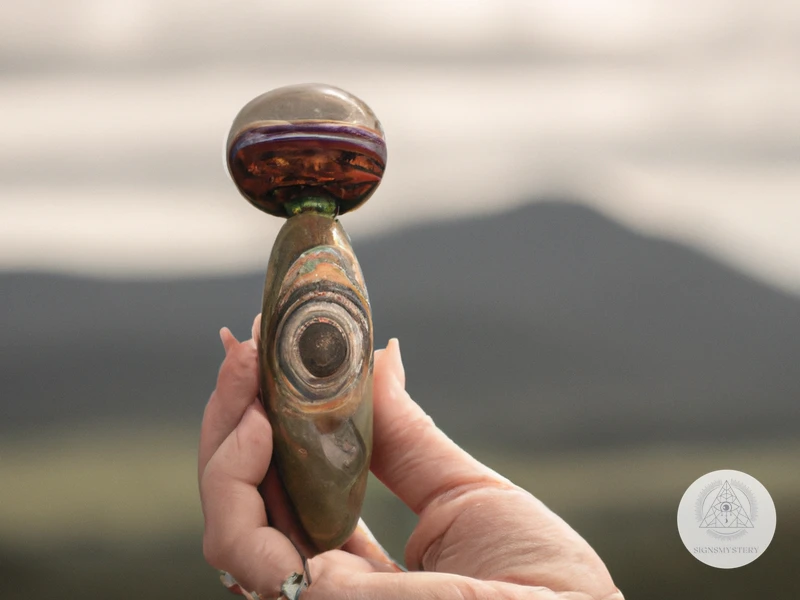
Using a shamanic rattle can be an integral part of a shamanic journey. To begin, it’s important to select a rattle that resonates with you personally, whether traditional or contemporary. Before starting a rattling session, prepare the space by setting intentions and creating a safe and inviting environment. Once the space is ready, begin the rattling process by setting an intention, holding the rattle with a strong grip, and allowing the rhythm to guide the journey. The sound of the rattle can aid in reaching altered states of consciousness and connecting with spirits and ancestors. Towards the end of the journey, gradually slow the rattling and offer gratitude to any spirits that were encountered. It’s important to remember that each shamanic journey is unique and personal, so allow for variations in the rattling process and trust your intuition.
Selecting a Personal Rattle
Choosing a personal shamanic rattle is an important decision for any shaman or enthusiast. There are certain factors that should be taken into consideration when selecting a rattle.
Firstly, it is important to choose a rattle that resonates with you. This means that the sound of the rattle should feel pleasing and calming to you.
Secondly, the material used in making the rattle is also important. Traditionally, rattles were made from natural materials like animal hides, gourds, and turtle shells. However, contemporary rattles are also made from synthetic materials like plastic and metals. Whatever material you choose, it should feel comfortable in your hands.
Thirdly, the design of the rattle is also significant. The colors and symbols on the rattle should have some spiritual significance or meaning to you. It could be a totem animal or a symbol that represents a certain spirit or energy.
Fourthly, the size and weight of the rattle should also be considered. Some shamanic journeys can
Subscribe to Our Newsletter
Sign up to receive the latest news and updates.
Lastly, it is always recommended to try out several rattles before selecting one as your personal rattle. This allows you to compare different sounds, designs, and materials, and find the one that feels perfect for you. It is also important to trust your intuition and follow your gut feeling when choosing a rattle.
Selecting a personal shamanic rattle can be a rewarding experience when you find the one that is perfect for you. It can deepen your spiritual practice and provide a tool for healing and connecting with spirits.
Preparing the Space for Rattling
Preparing the space for rattling is an essential part of shamanic practice. The shaman must create a sacred and safe space for the journey they are about to embark on. The space should be free from any distractions and disruptions. Here are some crucial steps for preparing the space for rattling.
| Step | Description |
|---|---|
| 1 | Cleanse the Space: Begin by cleaning the space physically by dusting, mopping, and decluttering. After that, perform a spiritual cleansing by smudging with sage or palo santo to remove any negative energy. |
| 2 | Create an Altar: Create an altar to honor the spirits and ancestors. Place a candle, crystals, flowers, and any other objects that have spiritual significance to the shaman. |
| 3 | Set Intentions: It is crucial to set intentions before the rattling ceremony. The shaman should ask the spirits and ancestors to protect and guide them on their journey. |
| 4 | Turn Off Technology: Turn off all technology, including phones, computers, and television to avoid any distractions or interruptions during the ceremony. |
| 5 | Create Sacred Space: After the cleaning and setting up the altar, create a sacred space by lighting candles and incense. This will help shift the energy and create a peaceful ambiance. |
| 6 | Invite Spirits: The shaman can invite spirits and ancestors to join the ceremony by calling out their names or lighting candles for them. The shaman should always approach the spirits and ancestors with respect and gratitude. |
Following the above steps, the shaman ensures that the space is cleansed, protected, and uplifted before the rattling journey. A conducive space helps the shaman to focus, connect with the spirits, and receive intuitive guidance during their journey.
The Rattling Process
The rattling process is the core of shamanic practice with rattles. Rattling helps the shaman or practitioner access altered states of consciousness, connect with the spirits, and facilitate healing. The following are the general steps involved in the rattling process:
1. Set the Intention: The first step in the rattling process is to set a clear and strong intention. The practitioner must have a specific goal or purpose for the journey, such as connecting with a spirit guide, receiving a healing, or gaining insight into a particular problem. This intention should be focused and stated aloud before beginning the journey.
2. Begin the Rattling: Once the intention is set, the practitioner begins to rattle. This involves holding the rattle in one hand and shaking it vigorously in a rhythmic pattern. The sound of the rattle serves as a focal point for the mind and helps to induce an altered state of consciousness. The practitioner may also sing or chant during the rattling process to deepen the trance state.
3. Enter the Journey: With the rattling as the focal point, the practitioner allows their consciousness to shift into an altered state. This may involve visualizing a passage or doorway and crossing over into a different realm, such as the spirit world or another dimension. Once the journey begins, the practitioner may encounter guides, spirits, or other beings that offer insights, guidance, or healing.
4. Explore and Gather Information: During the journey, the practitioner is free to explore and interact with the spirits and entities they encounter. They may ask questions, receive messages, or receive healing. The purpose of the journey is to gain information or insight that can be applied to the original intention.
5. End the Journey: Once the journey is complete, the practitioner stops the rattling and returns their consciousness to normal waking reality. They may take time to journal or reflect on the experience, or they may immediately apply the insights or healing gained from the journey.
It is important to note that the rattling process should always be approached with respect and reverence. The spirits and entities encountered during the journey are to be treated with honor and gratitude. The rattling process should also be done in a safe and sacred space, with protection and guidance from a trusted practitioner or teacher.
Ending the Journey
Ending the Journey
Just as it is important to prepare for a shamanic journey with a shamanic rattle, it is equally vital to end it properly. This allows you to return to your regular state of consciousness and integrate your experience.
There are various ways to end a shamanic journey, and the following are some of the most common:
- Ringing a bell or chime: The sound of a bell or chime can signify the end of your journey and help you to transition back to your normal state of consciousness.
- Smudging: Smudging with sage, palo santo, or other herbs can help to clear your energy and ground you after your journey.
- Journaling: Writing down your experiences and emotions can help you to process and integrate your journey.
- Reflection: Taking a few moments to sit in silence and reflect on your journey can be a powerful tool for gaining insight and clarity.
- Gratitude: Expressing gratitude for the journey and any messages received can help to solidify the experience and bring closure.
It is important to listen to your intuition and choose the method or methods that feel most appropriate to you. Whatever method you choose, it should help you to ground yourself and transition smoothly back into your regular state of consciousness.
The Future of Shamanic Rattles
Shamanic rattles have a rich cultural and spiritual history, and as such, they have become an important tool for many modern-day practitioners. As we move into the future, there is likely to be an increased interest in shamanic practices and the use of rattles in particular. With this increased interest, we may see contemporary adaptations of traditional designs, as well as new approaches to using rattles in shamanic practice. It is also possible that we may see rattles being used more widely in modern forms of healing, such as sound therapy. Whatever the future holds for shamanic rattles, it is clear that they have a powerful significance that is likely to endure for generations to come.
Contemporary Adaptations
In modern times, shamanic rattles have undergone several changes and contemporary adaptations. One of the changes is the materials used to create the rattles. Modern rattles can now be made from several materials such as plastic, metal, wood, and leather. Some contemporary rattles also include additional features such as LED lights and built-in speakers to enhance the experience of rattling.
Another contemporary adaptation is the use of shamanic rattles in music therapy. Music therapists use rattles to help individuals with various medical conditions, including anxiety, depression, and chronic pain. The rattles produce calming and soothing sounds that help individuals relax and release tension.
Additionally, contemporary shamanic communities have also started to incorporate digital shamanic rattles into their ceremonies. These digital rattles are often created using sound production software and can be played through speakers or headphones during shamanic journeys.
Some contemporary shamanic practitioners have also started to experiment with new designs of shamanic rattles. These designs incorporate modern art and graphic design elements to create visually striking and unique rattles. These contemporary rattles often have unconventional shapes and sizes, which give them a unique and fresh aesthetic.
However, despite the various contemporary adaptations, shamanic rattles are still considered essential tools in shamanism. The traditional use of rattles for inducing trance states and communicating with spirits has not changed significantly with the contemporary adaptations. The essence of the shamanic rattles remains the same, with their primary purpose being to help individuals connect with their spiritual selves and the divine realm.
Role in Modern Shamanism
The role of shamanic rattles in modern shamanism is constantly evolving, as more people are becoming interested in shamanic practices and adapting them to suit their contemporary lifestyles. Here are some of the key ways in which shamanic rattles are being used in modern shamanism:
1. Personal Empowerment: Modern shamanic practitioners are using rattles to help them connect with their inner power and overcome personal challenges. They may use the rattle as a tool for meditation or visualization, or carry it with them as a symbol of their strength and resilience.
2. Healing: Many modern shamanic healers use rattles as part of their healing practices. They may use the rattle to help them diagnose an illness or imbalance in the body, or to help move energy through the body during a healing session. Some practitioners also create personalized rattles for their clients to use during their healing process.
3. Community Connection: Rattles are often used in modern shamanic circles as a way to create a sense of community and connection among participants. The rhythmic sound of the rattle can help to unify the group and create a shared experience.
4. Rituals and Ceremonies: Rattles are often used in modern shamanic rituals and ceremonies. They may be used to set the tone and create a sacred space, or to enhance the energy of the ceremony. For example, a rattle may be shaken during a fire ceremony or used to honor the four directions.
5. Creative Expression: Some modern shamanic practitioners use rattles as a tool for creative expression. They may create unique rattles that reflect their personal style and spiritual journey, or incorporate rattles into their artwork or music.
The role of shamanic rattles in modern shamanism is multifaceted and constantly evolving. As shamanic practices continue to gain popularity in the modern world, it’s likely that we’ll see even more creative and innovative uses for rattles in the years to come.
Conclusion
In conclusion, shamanic rattles have a long and rich history in various cultures around the world. They were and continue to be an important tool in shamanism, aiding in the facilitation of spiritual journeys, healing, and connection with ancestors and spirits. The use of rattles remains prevalent in modern shamanic practices, with many contemporary adaptations and innovations to traditional designs.
When using a shamanic rattle, it is crucial to select a personal one that resonates with the individual’s energy. One should also properly prepare the space for rattling and follow a structured rattling process to ensure the journey is safe and effective.
While the popularity of shamanism has ebbed and flowed throughout history, many believe that there is a resurgence in interest and practice in recent years. As people seek alternative forms of healing and spirituality, shamanic rattles continue to play an important role in modern shamanism.
In summary, the history and importance of shamanic rattles cannot be understated. Their powerful influence in shamanic practices both past and present make them an indispensable tool for those on a spiritual journey. Whether using a traditional design or a contemporary adaptation, the shamanic rattle holds the potential for profound healing and connection with the spiritual realm.
Frequently Asked Questions
What is Shamanism?
Shamanism is a spiritual practice that involves connecting with the spirit world through meditation, ritual, and ceremony.
What are Shamanic Rattles?
Shamanic rattles are instruments used in shamanic practice to create a rhythmic sound that helps to alter consciousness and connect with the spirit world.
What are the Origins of Shamanism?
Shamanism is believed to have originated in Siberia over 10,000 years ago and spread throughout the world over time.
What Types of Materials are used for Shamanic Rattles?
Shamanic rattles can be made of various materials including gourds, animal hide, bone, wood, metal, and seeds.
What is the Purpose of Shamanic Rattles?
Shamanic rattles serve as an aid during shamanic journeys, facilitate healing, and provide a connection to ancestors and spirits.
How do you Use a Shamanic Rattle?
To use a shamanic rattle, select a personal rattle, prepare the space for rattling, begin the rattling process, and end the journey when ready.
What is the Role of Shamanic Rattles in Modern Shamanism?
Shamanic rattles still hold a significant role in modern shamanism as a tool for connecting with the spirit world and facilitating healing.
Can Anyone Use a Shamanic Rattle?
While anyone can use a shamanic rattle, it is recommended to receive proper training and guidance from a trained shaman or teacher.
What is the Benefit of Using a Shamanic Rattle?
Using a shamanic rattle can help to calm the mind, release stress and tension, and promote feelings of relaxation and peace.
What is the Future of Shamanic Rattles?
The future of shamanic rattles is likely to see continued adaptation and innovation while still remaining a core tool in shamanic practice.

